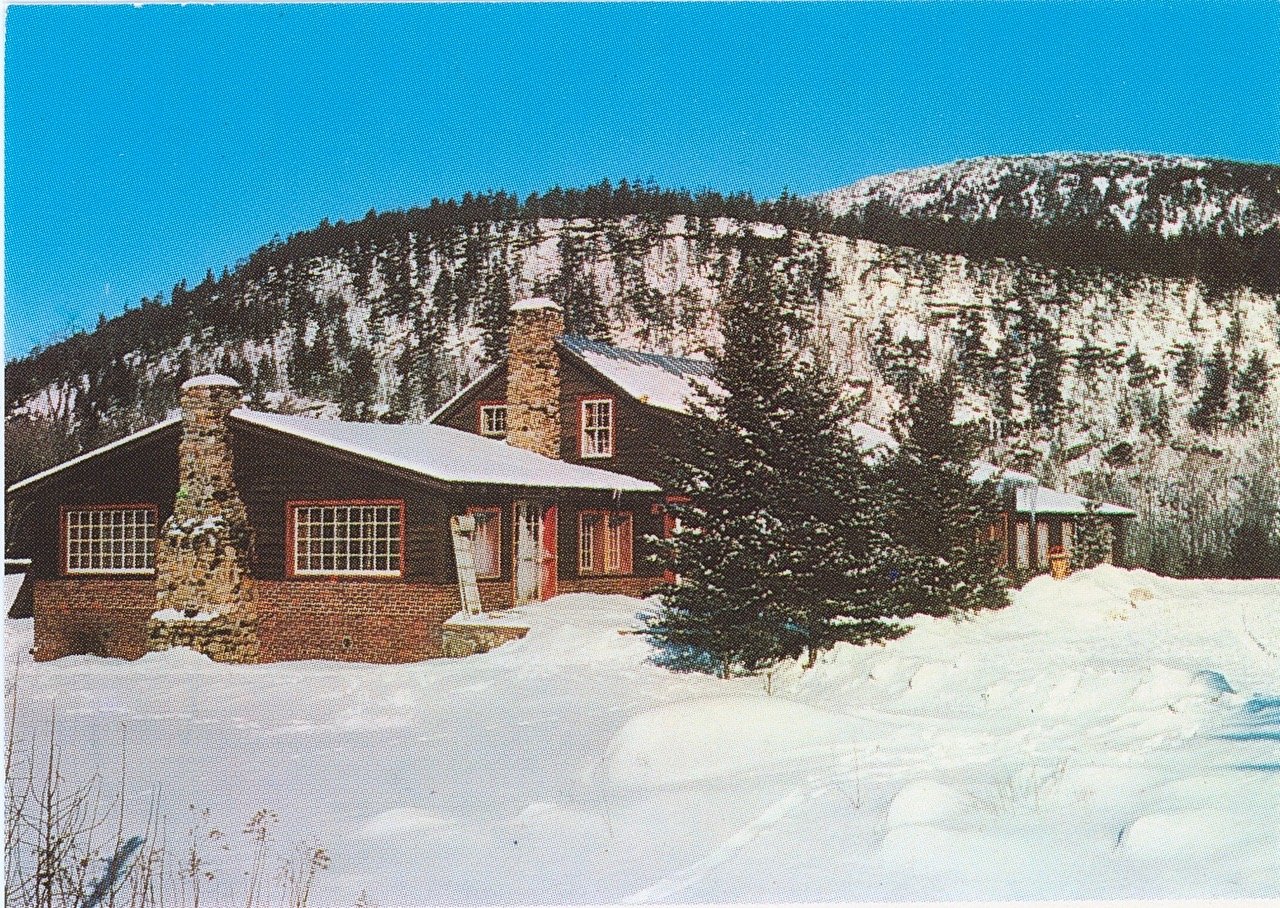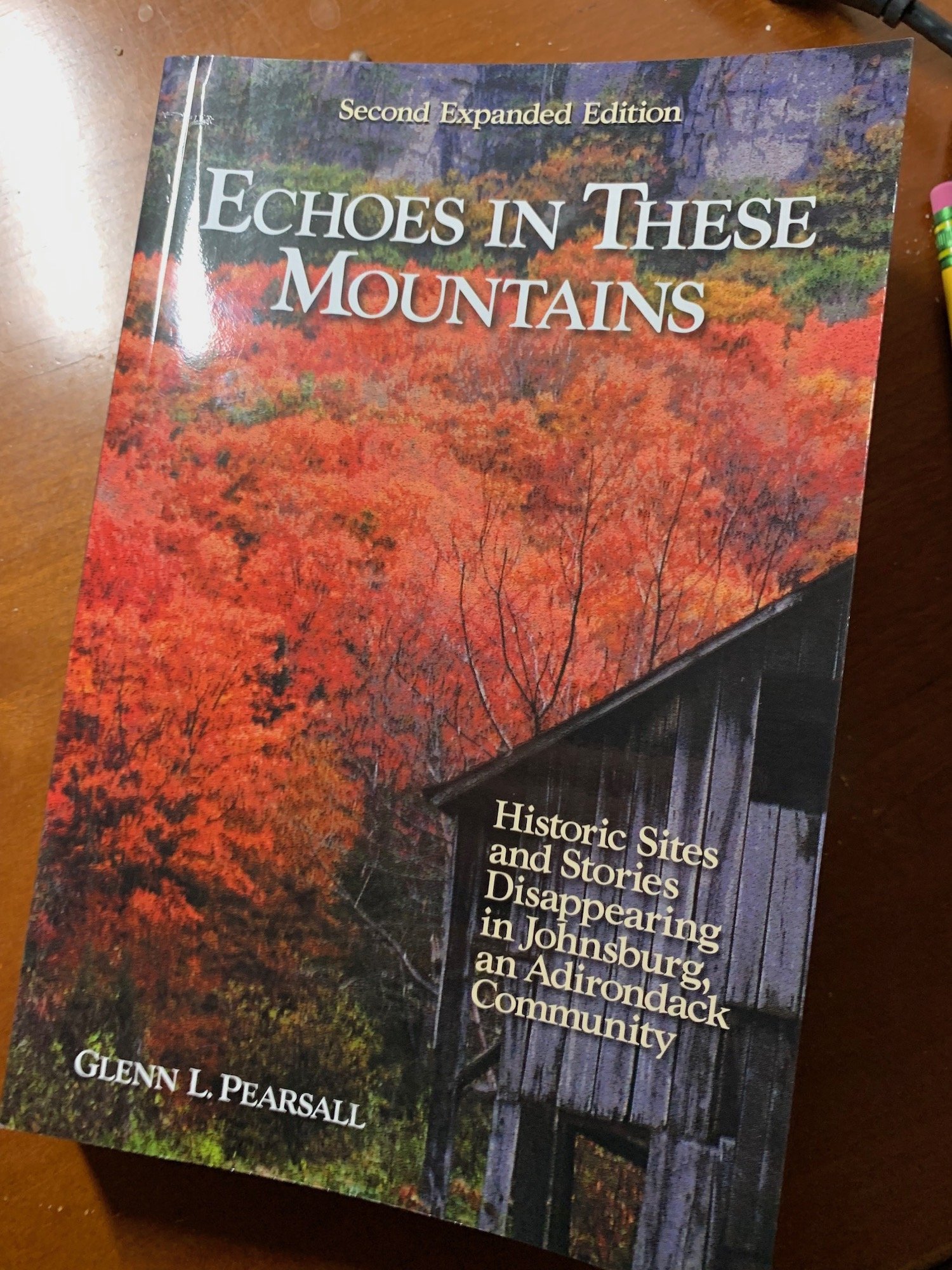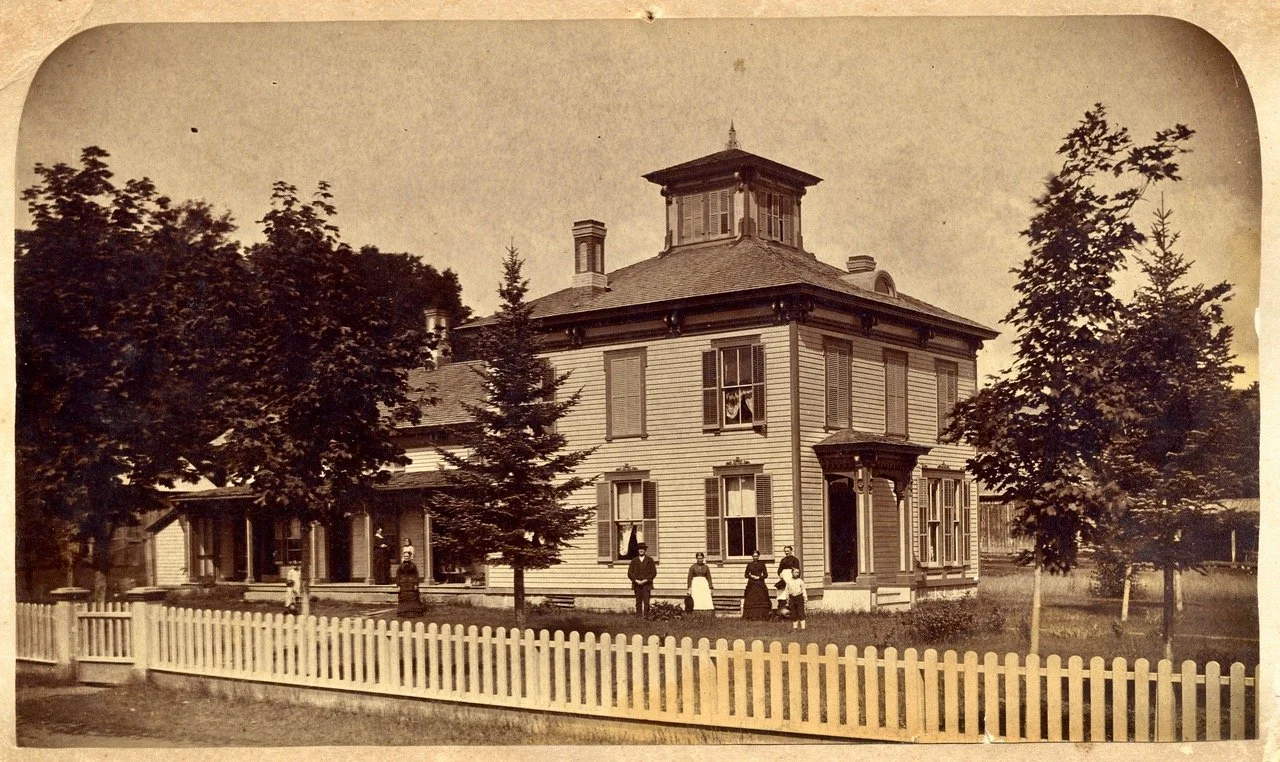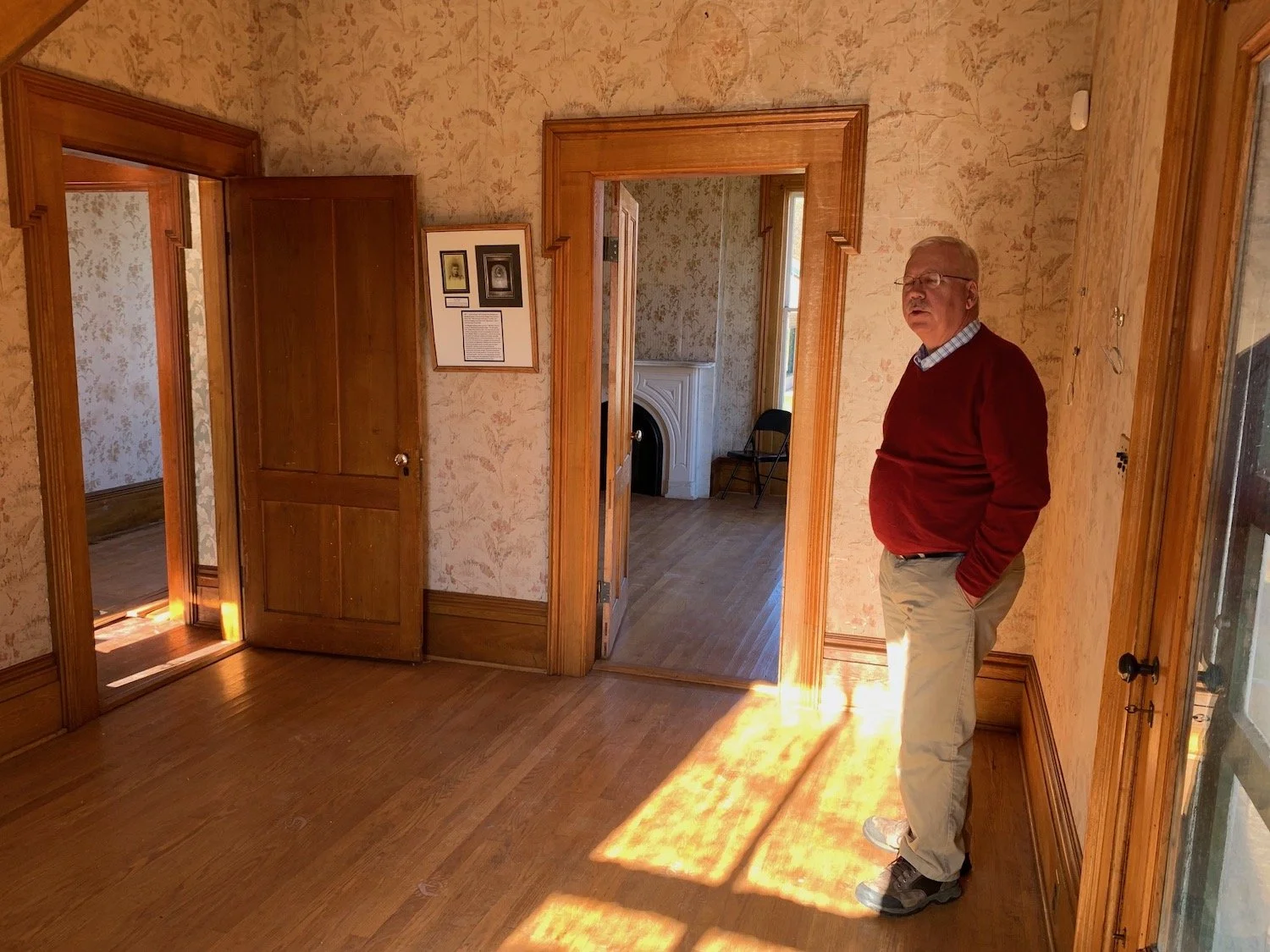A Conversation with Glenn Pearsall
I had been looking forward for a long time to sitting down with Glenn Pearsall. I finally had that opportunity after the dual December 10 book launch that he and Sterling Goodspeed hosted at the Johnsburg Town Library.
Sterling gave a reading from True North, his remarkable collection of short stories rooted in his youth in North Creek.
Glenn introduced his new expanded edition of Echoes in These Mountains, now a 512-page tome that describes 55 historic sites throughout the town of Johnsburg. Glenn and his wife Carol have lived since 1980 in a house they finished themselves, just west of Crane Mountain. The property was once part of an old dude ranch bought by his father in 1964, leaving Long Island, where Pearsalls had settled in 1644.
"Pearsall is a big name on Long Island," says Glenn. And so it is, as just a few clicks in Google will prove. Glenn's ancestor Henry Pearsall was one of the 16 founders of Hempstead and appointed magistrate (justice of the peace) by Dutch Governor Pieter Stuyvesant a few years later. What we know today as Lynbrook (Brook-lyn backwards) was originally called Pearsall's Corners. You'll find a historic marker at the site today, near Pearsall's Station, a restaurant that provides "fine dining in a casual atmosphere."
Arrival in Johnsburg
It was to this dude ranch at the base of Crane Mountain that Glenn's father brought the family in 1964. They called this the Buckskin Valley Lodge. Glenn and his wife Carol built their home on part of this property in 1980.
"My father liked doing different things," Glenn says. "When he got out of the service for World War II, he was in construction for a few years. My mother's father co-founded a bank in New York as a Fourth Federal Savings and Loan. Because of his construction background, my father was their mortgage officer.
"When he was forced out of the bank in a political upheaval, my father sold electronics for a few years, then started a sporting goods store, where I started working at age 11. We had 150 guns and shotguns. On Fridays, when my father would go out for dinner, I would be the only one running the store.
“The family had vacationed on Friends Lake near Chestertown since before I was born," he says. "In the summer of 1963, my father said, 'Enough. I'm tired of the rat race on Long Island. Let's move to the Adirondacks.’
"It took us a year to sell the house and store. The dude ranch he bought had been vacant for three years and it took eleven days to get running water in the place. All the fields were overgrown. There were all sorts of fence posts and barbed wire that had to be taken down.
"Prior to the closing of the property, my parents came up for Easter to show us kids what we were moving to. The driveway is a quarter-mile long and there were two feet of snow on it because it had not been plowed all winter. We had come up in a station wagon with my three younger brothers and two dogs. I got out of that station wagon and -- I can't explain it -- I felt I had come home.
"I'm not a spiritual person by nature. I just felt completely at ease with the place and my identity there. I subsequently bought 27 acres from my father and built a house with Carol, which we completed ourselves in 1980. We've lived there for the past 42 years within 100 feet of where I got out of that station wagon."
The First Edition
Glenn started researching "Echoes" in the 1970s. In the second edition, he has added more than 100 pages and boosted photos to more than 400. He also added an index.
The family ran the ranch as a lodge for vacationing families in the summer, and in the winter for skiers at Gore Mountain, which opened in 1964. Then his father got into construction and real estate. After Glenn graduated from college and spent four years in the Coast Guard during the Viet Nam Era, he and his father established Pearsall Realty in an 1865-era general store building at the intersection of Route 8 and Route 28.
"Our neighbor in Wevertown was Ernie Noxon, who was kind of a legend in this area, having made it into the Guinness Book of World Records for being reelected town clerk 30 times and spending 60 years in that position," Glenn recalls. "Ernie befriended me and would come over and we would start talking and he would share with me the history of the area because he'd grown up here.
"Soon thereafter, Lewis Waddell, who was the town historian, also would come and visit me. For such a small town, Johnsburg has a surprisingly rich history with national implications. I would share these stories when I was showing real estate to people, telling them a little more about the area. And one night as we were coming back from attending a music concert at Proctors in Schenectady with friends Woody and Elise Widlund, I shared some of those stories. Woody said, ”Glenn, you have to write this stuff down.’”
"I knew I was in trouble when my first draft was a hundred pages," he says. "I don't remember where the title came from, but Echoes in These Mountains had a ring to it.
"As I walk through the woods and find old foundations, they speak to me. You walk through the woods and suddenly you come across an old, abandoned road. You can see it was a road. But it's no longer on any maps. Along that road, you might find a foundation. You find the root cellar. You find apple trees. Look more closely, and you may find an old lilac bush. Why a lilac bush? As they were often planted near the outhouse, the explanation that makes the most sense to me is that they hoped the sweet smell of the followers would disguise the smell of the outhouse.
"If you walk through the woods, you pay attention. You come across these things, and they speak to you, like an echo."
The book ultimately came in at just over 400 pages. Glenn published 1,500 copies and gave them to the Johnsburg Historical Society to sell as a fundraiser. A decade later, he saw that the price asked on eBay for a signed used copy was listed at $114.
"That's when I decided it was time to produce a new edition."
The Second Edition
Glenn believes he has found the foundation of Matthew Brady's childhood home.
Glenn initially figured he would just fix a few typos and add more photos, but it became a much bigger three-year research project for new stories. He explored the roots of famed photojournalist Matthew Brady, who unquestionably grew up in Johnsburg and may or may not have been born there, and peered more deeply into the histories of such places as an Indian settlement near Thirteenth Lake marked on an 1855 map. He wrote on the history of the 1964 Wilderness Act drafted locally by Howard Zahniser, and the story of North Creek resident Dr. Thomas Durant, who drove the golden spike in Utah uniting the Transcontinental Railroad. And Glenn wrote about the slopes of Gore Mountain, where skiing, inspired by the 1932 Lake Placid Olympics, featured one the nation’s first “ride up-ski down" mountains.
"The expanded second edition now also includes over 440 historic photographs and my research on 175 soldiers from the Civil War from Johnsburg, which is a surprisingly large number for a small town. And I added an index."
The book was released last fall in a special limited edition of 800.
Glenn says that will be the last printing -- which is another reason we want to upload as much of Echoes as possible in text and photos in ArcGIS StoryMaps and in GPS-triggered audio narratives, built in STQRY, that visitors to Warren County may download to their phones.
Here’s the first chapter he has contributed to our project: The Underground Railroad at Mill Creek. As you’ll see, he has deeply researched the lives of Wesley Somerville and the Rev. Enos O. Putnam, both ardent abolitionists who felt so morally obligated to fight slavery that they left the parent Methodist Church, which would not adopt an anti-slavery stance, to start a new one. Joseph Leggett and the Rev. Joseph Baker and did the same in nearby Darrowsville, three miles south of Chester. You’ll find Donna Lagoy’s and Laura Seldman’s telling of that tale here.
Launching Our Story Cloud
Built in 1870 by lumber baron Robert Waddell, this 14-room house was Ernie Noxon's home for many years and will soon open as the Johnsburg Historical Society's new museum, thanks to Glenn's $132,000 donation.
We plan to make an introductory version of the First Wilderness Story Cloud available for downloading this summer when the Johnsburg Historical Society opens its new museum in the Robert and Electa Waddell House, which happens to sit alongside the site of the former general store in which Glenn and his father established Pearsall Realty.
Built in 1870 by lumber baron Robert Waddell, who served as Town Supervisor during the Civil War, "it's an architectural gem," says Glenn. Ernie Noxon lived here for many years, and it was from here that he would walk over to the Pearsall Realty office and join Glenn on Sundays when business was slow in the summer and share his stories.
"At one point he said, 'Glenn, the house is not for sale, but we need a physician in this area. This would make a nice physician's house and, if you could get a physician interested in it and moving into town, I’d sell it to him. I'd like to show it to you.’”
These are the stairs where, as Glenn recalls, Ernie Noxon piled his National Geographic magazines in stacks three feet high.
"So I was one of the very few people, to my knowledge, that ever got a personal tour of the house by Ernie Noxon. I was impressed by its black and pink marble fireplace and the plaster cornices, which were superbly done by Italian craftsmen. It has a great curved railing that leads upstairs. But what I best remember are the stacks of National Geographic magazines, three feet high, that we had to wind our way through to get to the second floor."
After ten years in real estate, Glenn entered E.F. Hutton's training program and went on to become a successful wealth manager, accumulating sufficient assets to establish the Glenn and Carol Pearsall Foundation, dedicated to improving the quality of life for year-round residents of the Adirondack Park.
"I like to focus on organizations that have reached an inflection point at which, with just the right amount of help, they can attain a whole new level. That's where the Historical Society was a few years ago. It was floundering. They had trouble putting a board together. They never had public space to display their exhibits and so they were never eligible for a permanent charter from the State Education Department. When we heard the house was for sale, we saw an opportunity to reinvigorate the Historical Society."
Glenn contacted Sterling Goodspeed, who was president of the society at that time and still is.
"You never know how a five-year plan is going to work out, but Sterling and his board put together a good proposal and, through the foundation, I gave them $132,000 to buy this 14-room gem of a house, which they're now working very hard to restore and open this summer."
Sterling is offering the First Wilderness Story Collaboration space to host a display at the museum's grand opening. Meanwhile, we're pulling out the stops to introduce at this event an audio GPS-triggered tour of the Gore Region in which we'll hear Glenn share the stories that Ernie Noxon told to him a half-century ago on those summer afternoons.
As President of the Johnsburg Historical Society, Sterling Goodspeed has been overseeing the renovation.
This sign soon will be installed in front of the Johnsburg Historical Society's new home.








